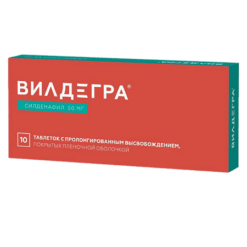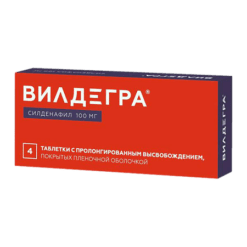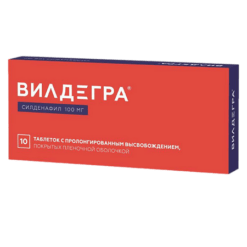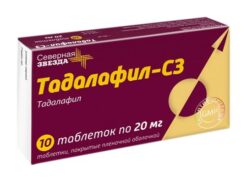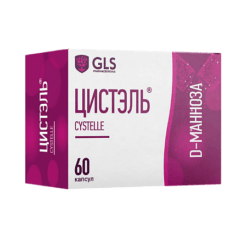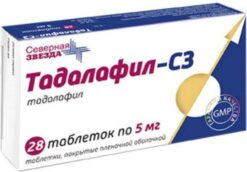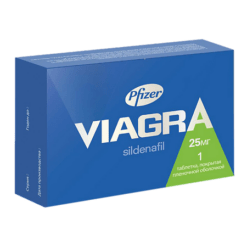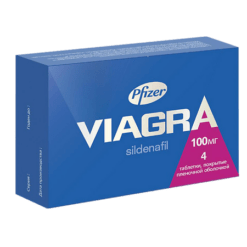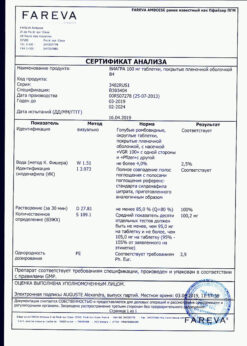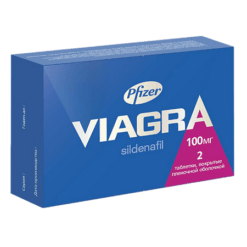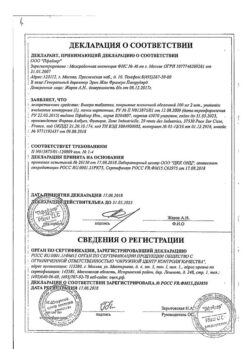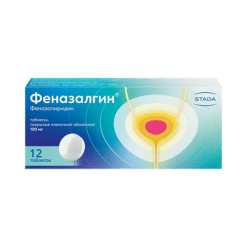No products in the cart.
Vildegra, 50 mg 4 pc
€1.00
Out of stock
(E-mail when Stock is available)
Description
Erectile dysfunction
Treatment of erectile dysfunction characterized by the inability to achieve or maintain an erection of the penis sufficient for satisfactory intercourse.
Indications
Indications
Treatment of erectile dysfunction, characterized by the inability to achieve or maintain a penile erection sufficient for satisfactory sexual intercourse.
Pharmacological effect
Pharmacological effect
Pharmacotherapeutic group:
Special instructions
Special instructions
To diagnose erectile dysfunction, determine its possible causes and select adequate treatment, it is necessary to obtain a complete medical history and conduct a thorough physical examination. Treatments for erectile dysfunction should be used with caution in patients with anatomical deformation of the penis (angulation, cavernous fibrosis, Peyronie’s disease), or in patients with risk factors for the development of priapism (sickle cell anemia, multiple myeloma, leukemia) (see section “With caution”). Medicines intended to treat erectile dysfunction should not be prescribed to men for whom sexual activity is undesirable.
If an erection persists for more than 4 hours, you should seek medical help. If priapism therapy is not carried out in a timely manner, this can lead to damage to the tissue of the penis and irreversible loss of potency.
Sexual activity poses a certain risk in the presence of heart disease, so before starting any therapy for erectile dysfunction, the doctor should refer the patient for an examination of the condition of the cardiovascular system. Sexual activity is undesirable in patients with heart failure, unstable angina, myocardial infarction or stroke in the last 6 months, life-threatening arrhythmias, arterial hypertension (BP > 170/100 mm Hg) or hypotension (BP < 90/50 mm Hg). Clinical studies showed no difference in the incidence of myocardial infarction (1.1 per 100 people per year) or the incidence of cardiovascular death (0.3 per 100 people per year) in patients receiving sildenafil compared with patients receiving placebo.
Cardiovascular complications
During post-marketing use of sildenafil for the treatment of erectile dysfunction, adverse events such as serious cardiovascular events (including myocardial infarction, unstable angina, sudden cardiac death, ventricular arrhythmia, hemorrhagic stroke, transient ischemic attack, hypertension and hypogenia) were reported, which were temporarily associated with the use of sildenafil. Most of these patients, but not all of them, had risk factors for cardiovascular complications. Many of these adverse events occurred shortly after sexual activity, and some of them occurred after taking sildenafil without subsequent sexual activity. It is not possible to establish a direct connection between the observed adverse events and these or other factors.
Hypotension
Sildenafil has a systemic vasodilating effect, leading to a transient decrease in blood pressure, which is not a clinically significant phenomenon and does not lead to any consequences in most patients. However, before prescribing sildenafil, the physician should carefully assess the risk of possible undesirable manifestations of the vasodilating effect in patients with relevant diseases, especially against the background of sexual activity. Increased susceptibility to vasodilators is observed in patients with obstruction of the left ventricular outflow tract (aortic stenosis, hypertrophic obstructive cardiomyopathy), as well as with the rare syndrome of multiple system atrophy, manifested by severe dysregulation of blood pressure from the autonomic nervous system. Since the combined use of sildenafil and α-blockers can lead to symptomatic hypotension in some sensitive patients, the drug should be prescribed with caution to patients taking α-blockers (see section “Interaction with other drugs”). To minimize the risk of postural hypotension in patients taking α-blockers, sildenafil should be started only after hemodynamic stability has been achieved in these patients. You should also consider the advisability of reducing the initial dose of sildenafil (see section “Dosage and Administration”). The physician should inform patients about what actions to take if symptoms of postural hypotension occur.
Visual impairment
Rare cases of anterior non-arteritic ischemic optic neuropathy as a cause of deterioration or loss of vision have been reported with the use of all PDE5 inhibitors, including sildenafil. Most of these patients had risk factors such as optic disc excavation, age over 50 years, diabetes mellitus, hypertension, coronary artery disease, hyperlipidemia, and smoking. A small number of patients with hereditary retinitis pigmentosa have genetically determined dysfunction of retinal phosphodiesterases. There is no information on the safety of sildenafil in patients with retinitis pigmentosa.
Hearing impairment
Some post-marketing and clinical studies have reported cases of sudden deterioration or loss of hearing associated with the use of all PDE5 inhibitors, including sildenafil. Most of these patients had risk factors for sudden deterioration or loss of hearing. A cause-and-effect relationship between the use of PDE5 inhibitors and sudden hearing loss or deterioration has not been established. If there is a sudden deterioration in hearing or hearing loss while taking sildenafil, you should consult your doctor immediately.
Bleeding
Sildenafil enhances the antiplatelet effect of sodium nitroprusside, a nitric oxide donor, on human platelets in vitro. There are no data on the safety of sildenafil in patients with a tendency to bleeding or exacerbation of gastric and duodenal ulcers, so sildenafil should be used with caution in these patients (see section “With caution”). The incidence of epistaxis in patients with pulmonary hypertension associated with diffuse connective tissue diseases was higher (sildenafil 12.9%, placebo 0%) than in patients with primary pulmonary hypertension (sildenafil 3.0%, placebo 2.4%). Patients receiving sildenafil in combination with a vitamin K antagonist had a higher incidence of epistaxis (8.8%) than patients not taking a vitamin K antagonist (1.7%).
Use in conjunction with other means of treating erectile dysfunction
The safety and effectiveness of sildenafil in combination with other drugs for the treatment of erectile dysfunction have not been studied, therefore the use of such combinations is not recommended (see section “Contraindications”),
Effect on the ability to drive a car and operate machinery
Since when taking sildenafil, a decrease in blood pressure, the development of chromatopsia, blurred vision, etc. is possible. side effects, you should be attentive to the individual effect of the drug in these situations, especially at the beginning of treatment and when changing the dosage regimen, and be careful when driving vehicles and engaging in potentially hazardous activities that require increased concentration and speed of psychomotor reactions.
Active ingredient
Active ingredient
Sildenafil
Composition
Composition
Active substance:
Pregnancy
Pregnancy
According to its registered indication, the drug is not intended for use in women.
Contraindications
Contraindications
Hypersensitivity to sildenafil or any other component of the drug. Use in patients receiving continuous or intermittent nitric oxide donors, organic nitrates or nitrites in any form, since sildenafil enhances the hypotensive effect of nitrates (see section “Interaction with other drugs”).
Use in patients for whom sexual activity is undesirable (for example, with severe cardiovascular diseases such as severe heart failure, unstable angina).
Arterial hypotension (blood pressure less than 90/50 mm Hg).
Severe renal failure (creatinine clearance <30 ml/min). Liver failure, cirrhosis.
A history of cerebrovascular accident or myocardial infarction within the last six months.
Hereditary degenerative diseases of the retina, including retinitis pigmentosa.
Lactose intolerance, lactase deficiency, glucose-galactose malabsorption.
Concomitant use of ritonavir (for dosages of 50 mg and 100 mg). The safety and effectiveness of sildenafil when used in combination with other drugs for the treatment of erectile dysfunction have not been studied, therefore the use of such combinations is not recommended (see section “Special Instructions”).
According to its registered indication, sildenafil is not intended for use in children under 18 years of age.
According to its registered indication, sildenafil is not intended for use in women.
With caution
Arterial hypertension (BP > 170/100 mm Hg).
Heart failure.
Life-threatening arrhythmias.
Anatomical deformation of the penis (angulation, cavernous fibrosis or Peyronie’s disease) (see section “Special instructions”).
Diseases predisposing to the development of priapism (sickle cell anemia, multiple myeloma, leukemia, platelet disease) (see section “Special instructions”).
Patients with a history of episodes of anterior non-arteritic ischemic optic neuropathy.
Diseases accompanied by bleeding.
Exacerbation of gastric and duodenal ulcers. Simultaneous use of alpha-blockers.
When taken simultaneously with ritonavir, the maximum single dose of sildenafil should not exceed 25 mg, the frequency of use is once every 48 hours (it is necessary to use a tablet with a dosage of 25 mg).
When taken simultaneously with inhibitors of the cytochrome CYP3A4 isoenzyme (erythromycin, saquinavir, ketoconazole, itraconazole), the initial dose of sildenafil should be 25 mg (a 25 mg tablet must be used).
Side Effects
Side Effects
Classification of the incidence of side effects (WHO): very often >1/10, often from >1/100 to 1/1000 to 1/10000 to <1/1000, very rarely from <1/10000, including isolated reports.
Interaction
Interaction
The influence of other drugs on the pharmacokinetics of sildenafil.
Overdose
Overdose
With a single dose of the drug up to 800 mg, adverse events were comparable to those when taking the drug in lower doses, but were more common.
Storage conditions
Storage conditions
In a place protected from light, at a temperature not exceeding 25 ° C.
Keep out of the reach of children.
Shelf life
Shelf life
3 years.
Manufacturer
Manufacturer
Ozon, Russia
Additional information
| Shelf life | 3 years. |
|---|---|
| Conditions of storage | In the dark place at the temperature not more than 25 °С. Keep out of reach of children. |
| Manufacturer | Ozon, Russia |
| Medication form | sustained release tablets |
| Brand | Ozon |
Other forms…
Related products
Buy Vildegra, 50 mg 4 pc with delivery to USA, UK, Europe and over 120 other countries.


